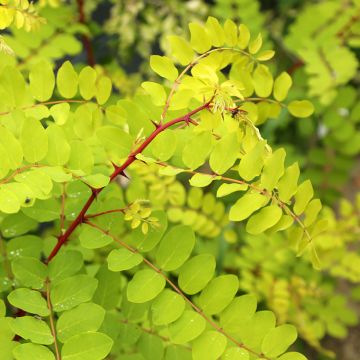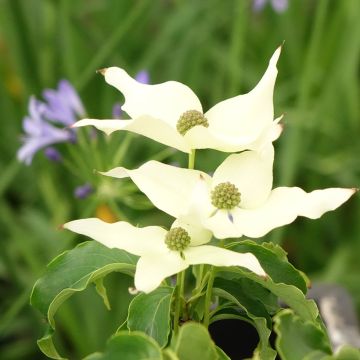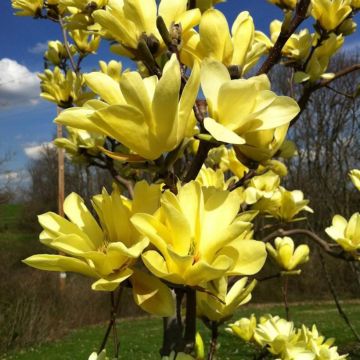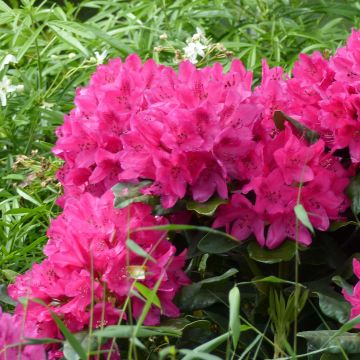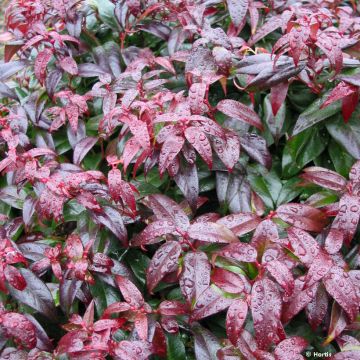

Robinia pseudoacacia Semperflorens - Black locust
Robinia pseudoacacia Semperflorens - Black locust
Robinia pseudoacacia Semperflorens
Black locust, False acacia
Why not try an alternative variety in stock?
View all →This plant carries a 24 months recovery warranty
More information
We guarantee the quality of our plants for a full growing cycle, and will replace at our expense any plant that fails to recover under normal climatic and planting conditions.
Oversize package: home delivery by special carrier from €6.90 per order..
Express home delivery from €8.90.
Delivery to Corse prohibited: UE law prohibits the import of this plant from mainland France to Corse as part of the fight against Xylella fastidiosa. Please accept our sincere apologies.
More information
Does this plant fit my garden?
Set up your Plantfit profile →
Description
Robinia pseudoacacia 'Semperflorens' is a variety of black locust that is capable of re-flowering throughout the summer. Its highly fragrant flowering, in long clusters of cream-white flowers, is edible and honey-producing. A beautiful deciduous tree with fine foliage and a light crown, it provides dappled shade without harming the companion plants. This superb tree is also more wind-resistant than the species that only flowers in spring. A very attractive tree to plant as a specimen in a large garden!
The locust 'Semperflorens' was discovered in France around 1870. It is derived from the black locust Robinia pseudoacacia, a tree native to the eastern U.S.A. from the legume family. In this family, plants are capable of assimilating atmospheric nitrogen at their roots and therefore do not need to extract it from the soil; this characteristic allows them to grow in poor mediums.
The black locust 'Semperflorens' differs from the species by having slightly less vigorous growth, better wind resistance, and especially by its ability to produce several waves of flowers, even though the spring bloom is much more abundant. This medium to large tree, has a loose and initially upright habit, with a crown that flattens and becomes broadly ovate as it matures. Its growth is vigorous, reaching on average 20 m high and 15 m wide. Its branches are thin and reddish-brown, with few thorns. Flowering begins in May-June, on individuals around ten years old. Particularly generous, it will re-bloom in August-September, albeit in a more modest manner. It is not uncommon for the tree to flower continuously from June to September, in moist soil. The pendulous inflorescences measure 10 to 20 cm long. They consist of butterfly-like flowers that are cream-white. This very fragrant flowering with an orange scent attracts pollinating insects and can be used in fritters. It is followed by the formation of flat, reddish pods containing a few rare brown bean-shaped seeds. Note that only the flowers can be consumed; the rest of the plant is highly toxic.
This Robinia 'Semperflorens' should be planted as a specimen in a park or large garden. To enhance its appearance, plant it in front of a screen of conifers (cypress, thujas, yews, junipers) or evergreen trees. It can also be associated, in a flowering grove, with other low-maintenance and highly ornamental trees or bushes such as the acacia 'Casque Rouge', Albizia 'Rouge de Tuilière', and Melia azedarach 'Jade Snowflake'.
Report an error about the product description
Plant habit
Flowering
Foliage
Botanical data
Robinia
pseudoacacia
Semperflorens
Papilionaceae
Black locust, False acacia
Cultivar or hybrid
Other Robinia - Black Locust
Planting and care
Robinia pseudoacacia 'Semperflorens' is easy to cultivate in all regions. It thrives in full sun, sheltered from strong winds, as its branches are somewhat brittle and the wind can damage its flowering. The soil should be light and well-drained, even poor, preferably moist, although this variety copes well with summer drought once established. It is sensitive to excessive clay, which can suffocate the roots. Its resistance to air pollution is excellent, making it valuable in urban areas. Prune dead or weak wood from August to October, to prevent sap flow. Also, remove any crossing branches to maintain the good shape of the Robinia. Beware of voles, which are fond of bark and attack the base of the plants.
Planting period
Intended location
Care
This item has not been reviewed yet - be the first to leave a review about it.
Spring-flowering shrubs
Haven't found what you were looking for?
Hardiness is the lowest winter temperature a plant can endure without suffering serious damage or even dying. However, hardiness is affected by location (a sheltered area, such as a patio), protection (winter cover) and soil type (hardiness is improved by well-drained soil).

Photo Sharing Terms & Conditions
In order to encourage gardeners to interact and share their experiences, Promesse de fleurs offers various media enabling content to be uploaded onto its Site - in particular via the ‘Photo sharing’ module.
The User agrees to refrain from:
- Posting any content that is illegal, prejudicial, insulting, racist, inciteful to hatred, revisionist, contrary to public decency, that infringes on privacy or on the privacy rights of third parties, in particular the publicity rights of persons and goods, intellectual property rights, or the right to privacy.
- Submitting content on behalf of a third party;
- Impersonate the identity of a third party and/or publish any personal information about a third party;
In general, the User undertakes to refrain from any unethical behaviour.
All Content (in particular text, comments, files, images, photos, videos, creative works, etc.), which may be subject to property or intellectual property rights, image or other private rights, shall remain the property of the User, subject to the limited rights granted by the terms of the licence granted by Promesse de fleurs as stated below. Users are at liberty to publish or not to publish such Content on the Site, notably via the ‘Photo Sharing’ facility, and accept that this Content shall be made public and freely accessible, notably on the Internet.
Users further acknowledge, undertake to have ,and guarantee that they hold all necessary rights and permissions to publish such material on the Site, in particular with regard to the legislation in force pertaining to any privacy, property, intellectual property, image, or contractual rights, or rights of any other nature. By publishing such Content on the Site, Users acknowledge accepting full liability as publishers of the Content within the meaning of the law, and grant Promesse de fleurs, free of charge, an inclusive, worldwide licence for the said Content for the entire duration of its publication, including all reproduction, representation, up/downloading, displaying, performing, transmission, and storage rights.
Users also grant permission for their name to be linked to the Content and accept that this link may not always be made available.
By engaging in posting material, Users consent to their Content becoming automatically accessible on the Internet, in particular on other sites and/or blogs and/or web pages of the Promesse de fleurs site, including in particular social pages and the Promesse de fleurs catalogue.
Users may secure the removal of entrusted content free of charge by issuing a simple request via our contact form.
The flowering period indicated on our website applies to countries and regions located in USDA zone 8 (France, the United Kingdom, Ireland, the Netherlands, etc.)
It will vary according to where you live:
- In zones 9 to 10 (Italy, Spain, Greece, etc.), flowering will occur about 2 to 4 weeks earlier.
- In zones 6 to 7 (Germany, Poland, Slovenia, and lower mountainous regions), flowering will be delayed by 2 to 3 weeks.
- In zone 5 (Central Europe, Scandinavia), blooming will be delayed by 3 to 5 weeks.
In temperate climates, pruning of spring-flowering shrubs (forsythia, spireas, etc.) should be done just after flowering.
Pruning of summer-flowering shrubs (Indian Lilac, Perovskia, etc.) can be done in winter or spring.
In cold regions as well as with frost-sensitive plants, avoid pruning too early when severe frosts may still occur.
The planting period indicated on our website applies to countries and regions located in USDA zone 8 (France, United Kingdom, Ireland, Netherlands).
It will vary according to where you live:
- In Mediterranean zones (Marseille, Madrid, Milan, etc.), autumn and winter are the best planting periods.
- In continental zones (Strasbourg, Munich, Vienna, etc.), delay planting by 2 to 3 weeks in spring and bring it forward by 2 to 4 weeks in autumn.
- In mountainous regions (the Alps, Pyrenees, Carpathians, etc.), it is best to plant in late spring (May-June) or late summer (August-September).
The harvesting period indicated on our website applies to countries and regions in USDA zone 8 (France, England, Ireland, the Netherlands).
In colder areas (Scandinavia, Poland, Austria...) fruit and vegetable harvests are likely to be delayed by 3-4 weeks.
In warmer areas (Italy, Spain, Greece, etc.), harvesting will probably take place earlier, depending on weather conditions.
The sowing periods indicated on our website apply to countries and regions within USDA Zone 8 (France, UK, Ireland, Netherlands).
In colder areas (Scandinavia, Poland, Austria...), delay any outdoor sowing by 3-4 weeks, or sow under glass.
In warmer climes (Italy, Spain, Greece, etc.), bring outdoor sowing forward by a few weeks.



































